ILO 133号公约(船员舱室设备)--中英文
- 格式:pdf
- 大小:140.28 KB
- 文档页数:14
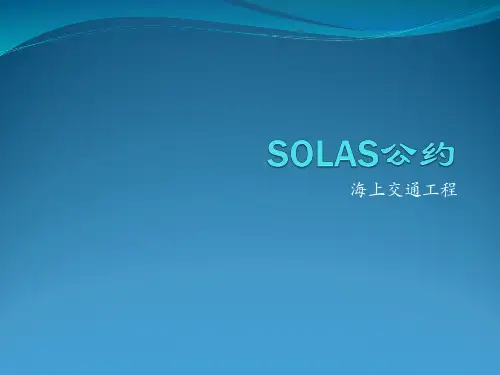
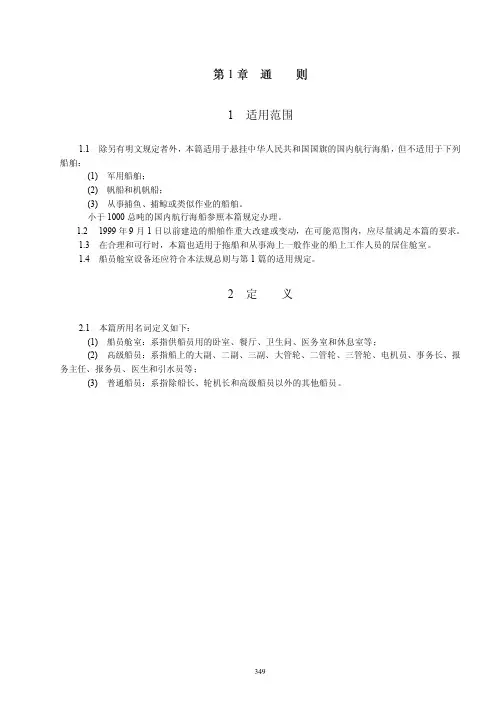
11适用范围1.1除另有明文规定者外,本篇适用于悬挂中华人民共和国国旗的国内航行海船,但不适用于下列船舶:(1)军用船舶;(2)帆船和机帆船;(3)从事捕鱼、捕鲸或类似作业的船舶。
小于1000总吨的国内航行海船参照本篇规定办理。
1.2 1999年9月1日以前建造的船舶作重大改建或变动,在可能范围内,应尽量满足本篇的要求。
1.3在合理和可行时,本篇也适用于拖船和从事海上一般作业的船上工作人员的居住舱室。
1.4船员舱室设备还应符合本法规总则与第1篇的适用规定。
2定义2.1本篇所用名词定义如下:(1)船员舱室:系指供船员用的卧室、餐厅、卫生问、医务室和休息室等;(2)高级船员:系指船上的大副、二副、三副、大管轮、二管轮、三管轮、电机员、事务长、报务主任、报务员、医生和引水员等;(3)普通船员:系指除船长、轮机长和高级船员以外的其他船员。
21卧室1.1卧室应位于最高载重线以上船的中部或后部。
当船舶的尺度、类型或营运条件受限制,卧室布置在船的中部或后部为不可能时,经同意,卧室可布置在船的前部,但无论如何不能布置在防撞舱壁之前。
对客船,在照明和通风满意的情况下,经同意,卧室可布置在最高载重线以下,但不得直接布置在作业通道的下方。
油船、散装运输危险化学品船和散装运输液化气体船等的船员舱室布置,应符合本法规有关篇章的要求。
报务员的卧室应尽可能靠近无线电工作室,但不能设在其内。
1.2普通船员卧室的最高定员,除客船为4人1间外,其他船舶一般为2人l 问。
1.3高级船员卧室一般为1人1间。
1.4等于或大于3000总吨的船舶,如有可能,应为船长、轮机长和大副提供1间与卧室相邻的会客室或工作室。
1.5船员卧室的人均甲板面积一般应不小于表1.5的规定。
1.6配有与卧室相邻的会客室或工作室时,该会客室或工作室的甲板面积一般应与表1.5中普通船员(单人间)要求相同。
1.7船长和轮机长的卧室甲板面积应不小于表1.5中高级船员要求的甲板面积。
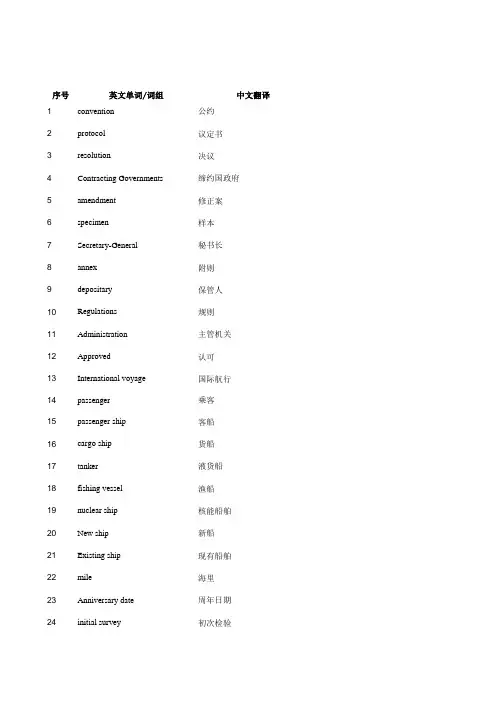

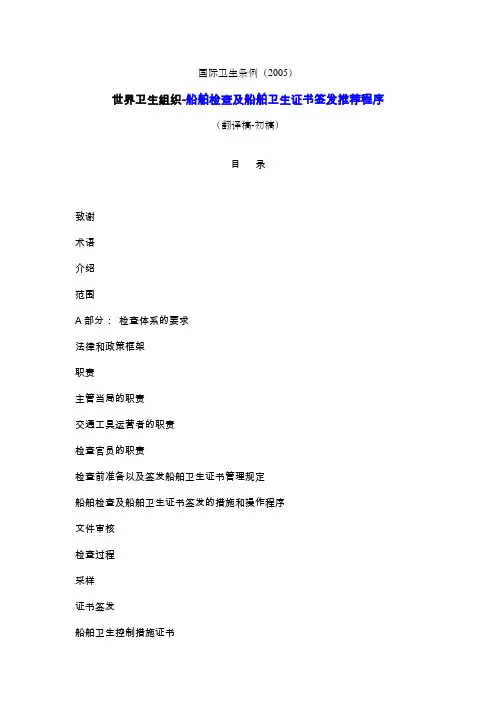
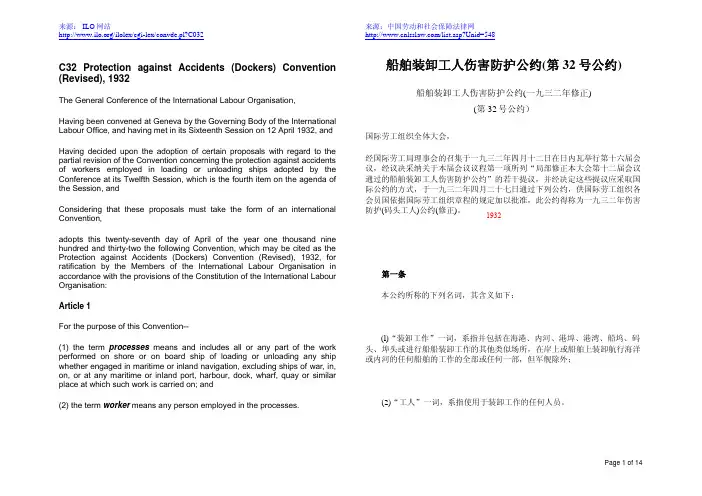
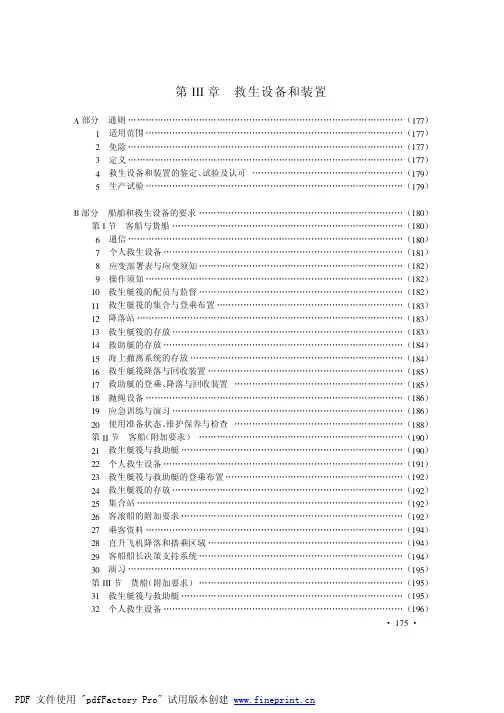
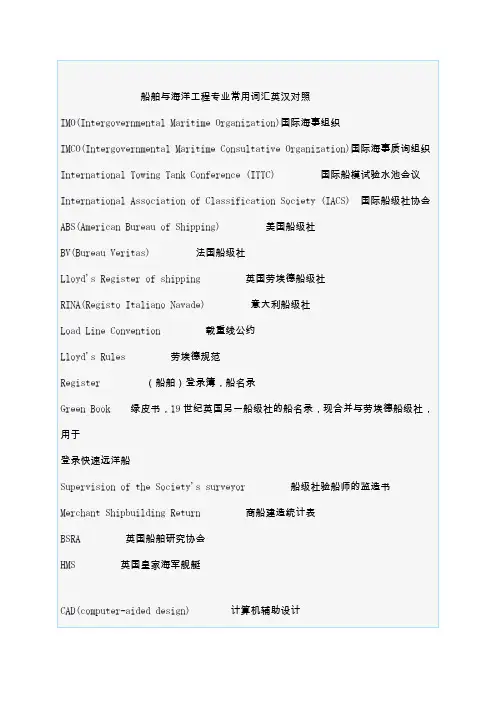
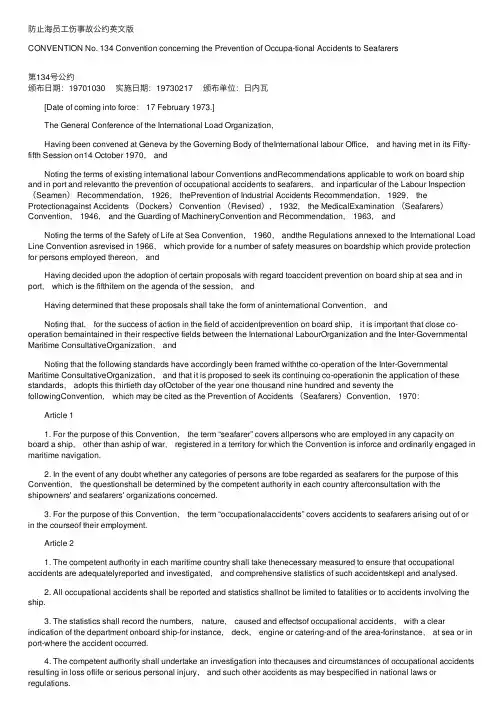
防⽌海员⼯伤事故公约英⽂版CONVENTION No. 134 Convention concerning the Prevention of Occupa-tional Accidents to Seafarers第134号公约颁布⽇期:19701030 实施⽇期:19730217 颁布单位:⽇内⽡ [Date of coming into force: 17 February 1973.] The General Conference of the International Load Organization, Having been convened at Geneva by the Governing Body of theInternational labour Office, and having met in its Fifty-fifth Session on14 October 1970, and Noting the terms of existing international labour Conventions andRecommendations applicable to work on board ship and in port and relevantto the prevention of occupational accidents to seafarers, and inparticular of the Labour Inspection (Seamen) Recommendation, 1926, thePrevention of Industrial Accidents Recommendation, 1929, the Protectionagainst Accidents (Dockers) Convention (Revised), 1932, the MedicalExamination (Seafarers)Convention, 1946, and the Guarding of MachineryConvention and Recommendation, 1963, and Noting the terms of the Safety of Life at Sea Convention, 1960, andthe Regulations annexed to the International Load Line Convention asrevised in 1966, which provide for a number of safety measures on boardship which provide protection for persons employed thereon, and Having decided upon the adoption of certain proposals with regard toaccident prevention on board ship at sea and in port, which is the fifthitem on the agenda of the session, and Having determined that these proposals shall take the form of aninternational Convention, and Noting that, for the success of action in the field of accidentprevention on board ship, it is important that close co-operation bemaintained in their respective fields between the International LabourOrganization and the Inter-Governmental Maritime ConsultativeOrganization, and Noting that the following standards have accordingly been framed withthe co-operation of the Inter-Governmental Maritime ConsultativeOrganization, and that it is proposed to seek its continuing co-operationin the application of these standards, adopts this thirtieth day ofOctober of the year one thousand nine hundred and seventy the followingConvention, which may be cited as the Prevention of Accidents (Seafarers)Convention, 1970: Article 1 1. For the purpose of this Convention, the term “seafarer” covers allpersons who are employed in any capacity on board a ship, other than aship of war, registered in a territory for which the Convention is inforce and ordinarily engaged in maritime navigation. 2. In the event of any doubt whether any categories of persons are tobe regarded as seafarers for the purpose of this Convention, the questionshall be determined by the competent authority in each country afterconsultation with the shipowners' and seafarers' organizations concerned. 3. For the purpose of this Convention, the term “occupationalaccidents” covers accidents to seafarers arising out of or in the courseof their employment. Article 2 1. The competent authority in each maritime country shall take thenecessary measured to ensure that occupational accidents are adequatelyreported and investigated, and comprehensive statistics of such accidentskept and analysed. 2. All occupational accidents shall be reported and statistics shallnot be limited to fatalities or to accidents involving the ship. 3. The statistics shall record the numbers, nature, caused and effectsof occupational accidents, with a clear indication of the department onboard ship-for instance, deck, engine or catering-and of the area-forinstance, at sea or in port-where the accident occurred. 4. The competent authority shall undertake an investigation into thecauses and circumstances of occupational accidents resulting in loss oflife or serious personal injury, and such other accidents as may bespecified in national laws or regulations. Article 3 In order to provide a sound basis for the prevention of accidentswhich are due to particular hazards of maritime employment, research shallbe undertaken into general trends and into such hazards as are brought outby statistics. Article 4 1. Provisions concerning the prevention of occupational accidentsshall be laid down by laws or regulations, codes of practice or otherappropriate means. 2. These provisions shall refer to any general provisions on theprevention of accidents and the protection of health in employment whichmay be applicable to the work of seafarers, and shall specify measuresfor the prevention of accidents which are peculiar to maritime employment. 3. In particular, these provisions shall cover the following matters: (a) general and basic provisions; (b) structural features of the ship; (c) machinery; (d) special safety measures on and below deck; (e) loading and unloading equipment; (f) fire prevention and fire-fighting; (g) anchors, chains and lines; (h) dangerous cargo and ballast; (i) personal protective equipment for seafarers. Article 5 1. The accident prevention provisions referred to in Article 4 shallclearly specify the obligation of shipowners, seafarers and othersconcerned to comply with them. 2. Generally, any obligation on the shipowner to provide protectiveequipment or other accident prevention safeguards shall be accompanied byprovision for the use of such equipment and safeguards by seafarers and arequirement that they comply with the relevant accident preventionmeasures. Article 6 1. Appropriate measures shall be taken to ensure the properapplication of the provisions referred to in Article 4, by means ofadequate inspection or otherwise. 2. Appropriate measures shall be taken to ensure compliance with theseprovisions. 3. All necessary steps shall be taken to ensure that inspection andenforcement authorities are familiar with maritime employment and itspractices. 4. In order to facilitate application, copies or summaries of theprovisions shall be brought to the attention of seafarers,for instance bydisplay in a prominent position on board ship. Article 7 Provision shall be made for the appointment, from amongst the crew ofthe ship, of a suitable person or suitable persons or of a suitablecommittee responsible, under the Master, for accident prevention. Article 8 1. Programmes for the prevention of occupational accidents shall beestablished by the competent authority with the co-operation ofshipowners' and seafarers' organizations. 2. Implementation of such programmes shall be so organized that thecompetent authority, shipowners and seafarers or their representativesand other appropriate bodies may play an active part. 3. In particular, national or local joint accident preventioncommittees or ad hoc working parties, on which both shipowners' andseafarers' organizations are represented, shall be established. Article 9 1. The competent authority shall promote and, in so far as appropriateunder national conditions, ensure the inclusion, as part of theinstruction in professional duties, of instruction in the prevention ofaccidents and in measures for the protection of health in employment inthe curricula, for all categories and grades of seafarers, of vocationaltraining institutions. 2. All appropriate and practicable measures shall also be taken tobring to the attention of seafarers information concerning particularhazards, for instance by means of official notices containing relevantinstructions. Article 10 Members, with the assistance as appropriate of intergovernmental andother international organizations, shall endeavour, in co-operation witheach other, to achieve the greatest possible measure of uniformity ofother action for the prevention of occupational accidents. Article 11 The formal ratifications of this Convention shall be communicated tothe Director-General of the International Labour Office for registration. Article 12 1. This Convention shall be binding only upon those Members of theInternational Labour Organization whose ratifications have been registeredwith the Director-General. 2. It shall come into force twelve months after the date on which theratifications of two Members have been registered with theDirector-General. 3. Thereafter, this Convention shall come into force for any Membertwelve months after the date on which its ratification has beenregistered. Article 13 1. A Member which has ratified this Convention may denounce it afterthe expiration of ten years from the date on which the Convention firstcomes into force, by an act communicated to the Director-General of theInternational Labour Office for registration. Such denunciation shall nottake effect until one year after the date on which it is registered. 2. Each Member which has ratified this Convention and which does not,within the year following the expiration of the period of ten yearsmentioned in the preceding paragraph, exercise the right of denunciationprovided for in this Article, will be bound for another period of tenyears and, thereafter, may denounce this Convention at the expiration ofeach period of ten years under the terms provided for in this Article. Article 14 1. The Director-General of the International Labour Office shallnotify all Members of the International Labour Organization of theregistration of all ratifications and denunciations communicated to him bythe Members of the Organization. 2. When notifying the Members of the Organization of the registrationof the second ratification communicated to him,the Director-General shalldraw the attention of the Members of the Organization to the date uponwhich the Convention will come into force. Article 15 The Director-General of the International Labour Office shallcommunicate to the Secretary-General of the United Nations forregistration in accordance with Article 102 of the Charter of the UnitedNations full particulars of all ratifications and acts of denunciationregistered by him in accordance with the p r o v i s i o n s o f t h e p r e c e d i n g A r t i c l e . / p > p b d s f i d = "1 1 8 " > 0 0 A r t i c l e 1 6 / p > p b d s f i d = " 1 1 9 " > 0 0 A t s u c h t i m e s a s i t m a y c o n s i d e r n e c e s s a r y t h e G o v e r n i n g B o d y o f t h e I n t e r n a t i o n a l L a b o u r O f f i c e s h a l l p r e s e n t t o t h e G e n e r a l C o n f e r e n c e a r e p o r t o n t h e w o r k i n g o f t h i s C o n v e n t i o n a n d s h a l l e x a m i n e t h e d e s i r a b i l i t y o f p l a c i n g o n th e a g e n d a o f t h e C o n f e r e n c e t h e q u e s t i o n o f i t s r e v i s i o n i n w h o l e o r i n p a r t . / p > p b d s f i d = " 12 0 " > 0 0 A r t i c l e 1 7 / p >。
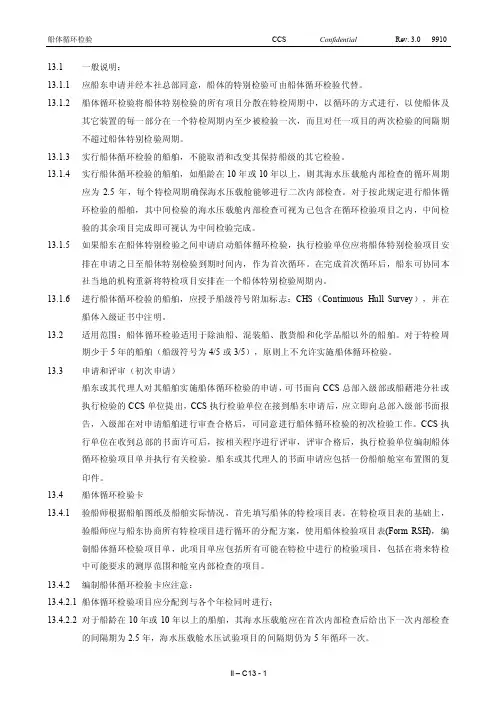
13.1一般说明:13.1.1应船东申请并经本社总部同意,船体的特别检验可由船体循环检验代替。
13.1.2船体循环检验将船体特别检验的所有项目分散在特检周期中,以循环的方式进行,以使船体及其它装置的每一部分在一个特检周期内至少被检验一次,而且对任一项目的两次检验的间隔期不超过船体特别检验周期。
13.1.3实行船体循环检验的船舶,不能取消和改变其保持船级的其它检验。
13.1.4实行船体循环检验的船舶,如船龄在10年或10年以上,则其海水压载舱内部检查的循环周期应为2.5年,每个特检周期确保海水压载舱能够进行二次内部检查。
对于按此规定进行船体循环检验的船舶,其中间检验的海水压载舱内部检查可视为已包含在循环检验项目之内,中间检验的其余项目完成即可视认为中间检验完成。
13.1.5如果船东在船体特别检验之间申请启动船体循环检验,执行检验单位应将船体特别检验项目安排在申请之日至船体特别检验到期时间内,作为首次循环。
在完成首次循环后,船东可协同本社当地的机构重新将特检项目安排在一个船体特别检验周期内。
13.1.6进行船体循环检验的船舶,应授予船级符号附加标志:CHS(Continuous Hull Survey),并在船体入级证书中注明。
13.2适用范围:船体循环检验适用于除油船、混装船、散货船和化学品船以外的船舶。
对于特检周期少于5年的船舶(船级符号为4/5或3/5),原则上不允许实施船体循环检验。
13.3申请和评审(初次申请)船东或其代理人对其船舶实施船体循环检验的申请,可书面向CCS总部入级部或船藉港分社或执行检验的CCS单位提出,CCS执行检验单位在接到船东申请后,应立即向总部入级部书面报告,入级部在对申请船舶进行审查合格后,可同意进行船体循环检验的初次检验工作。
CCS执行单位在收到总部的书面许可后,按相关程序进行评审,评审合格后,执行检验单位编制船体循环检验项目单并执行有关检验。
船东或其代理人的书面申请应包括一份船舶舱室布置图的复印件。
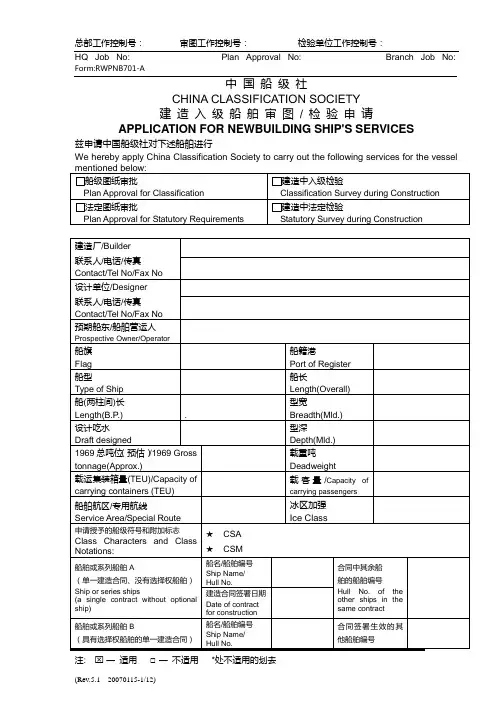
中国船级社CHINA CLASSIFICATION SOCIETY建造入级船舶审图/ 检验申请APPLICATION FOR NEWBUILDING SHIP'S SERVICES兹申请中国船级社对下述船舶进行We hereby apply China Classification Society to carry out the following services for the vessel(1) 建造合同日期定义Definition of date of “Contract for Construction “ as per IACS PR 29 (Rev.2):The date of “Contract for Construction “of a vessel is the date on which the contract to build the vessel is signed between prospective owner and the shipbuilder. This date and construction numbers (i e Hull Numbers) of all vessels include the contract are to be declared to the classification by the party applying assignment of class fora new building.建造合同日期是由预期的船东和船厂之间签署一艘船舶的建造合同日期。
其合同(涉及所有船舶)日期和船舶建造工程号(如船厂编号)应由申请建造入级的申请方向入级船级社提出书面声明。
(2)系列姐妹船(a series of sister vessels):“a series of sister vessels”is a series of vessels built to the same approved plans for classification purpose, under a single contract for construction.系列姐妹船是在一个单一合同中标明的按照相同批准图纸建造的船舶。
solas公约中英文对照版本
【最新版】
目录
1.SOLAS 公约简介
2.SOLAS 公约的主要内容
3.SOLAS 公约的中英文对照版本概述
4.SOLAS 公约中英文对照版本的具体内容
5.SOLAS 公约中英文对照版本的重要性
正文
SOLAS 公约,全称为“国际海上人命安全公约”,是国际海事组织(IMO)制定的一项重要国际公约,旨在保障海上人命安全,防止海上事故的发生。
自 1974 年通过以来,SOLAS 公约已经成为国际海事领域的权威法规,得到了全球大多数国家的认可和遵守。
SOLAS 公约主要包括以下内容:船舶构造、设备和维修;船员资格和训练;船舶安全管理;海上航行和气象服务;搜救和事故调查等。
这些内容涵盖了海上人命安全的方方面面,为保障海上航行的安全提供了一套完整的制度体系。
SOLAS 公约的中英文对照版本是为了方便我国船员和相关从业人员
更好地理解和遵守公约内容而制定的。
中英文对照版本将公约的全部条款进行了中文和英文的对照翻译,使得船员和相关人员能够更加准确地理解公约的精神和要求。
SOLAS 公约中英文对照版本的具体内容包括:船舶安全管理条款、船员培训和资格认证条款、船舶设备和维修条款、海上航行和气象服务条款等。
这些条款的对照翻译,对于提高我国船员的国际竞争力,保障我国海上运输的安全,具有重要的意义。
SOLAS 公约中英文对照版本的重要性不言而喻。
2500TEU集装箱船技术规格书2004.7中国船舶设计研究院章节0通则0.1 简介一般描述.本规格书对该船作了详细的描述以便建造者完全按照0。
11章节的规则交付该船。
对规格书的理解如下:1.在规格书中出现多次的机械设备、备件等仅提供一次。
2.在规格书中所列设备可以以相似的设备来替代,但须得到船东的同意。
3.规格书中的尺寸公差满足制造厂和船厂的要求。
4.所有的设备按制造厂的标准建造和试验。
5.除非在0。
11节提到的规则、规范的要求,在规格书中未提到的设备将不提供(除船东供品)。
6.该船和设备的参数中提到的“大约”,建造方可以合理的调整。
如出现本规格书的各章节互相矛盾和抵触,船体部分仅按船体章节,甲板机械仅按甲板机械部分的章节,舱室部分仅对应舱室设备和布置及油漆部分的相关条款,机舱和管系、电气部分、空调冷藏亦同样。
可以认为章节“0”优先于本规格书的其他章节。
0。
2 船型和一般特性该船为集装箱船装以下货物:1.在甲板和货舱内装20和40英尺ISO标准集装箱2.在机舱上甲板装45英尺集装箱。
3.舱口盖上装欧洲箱。
4.400只冷藏集装箱插座,200只在主甲板和舱口盖上,200只在3、4、5货舱内(2层)。
该船为单机,B干舷,固定浆,低速二冲程船用柴油机,该船有5个货舱,机舱和上棚在尾部,横向结构,对称尾,球鼻首,一个平衡舵,首侧推和封闭桥楼。
该船将装运下列IMO的危险品集装箱:1#货舱:1, 2, 3, 4, 5.1, 6.1, 8 & 9类危险品。
2#,3#,4#货舱:1.4S, 2, 3, 4, 5.1, 6.1, 8 & 9类危险品。
5#货舱危险品的装载位置离首侧推舱的距离至少为3米。
三台克令吊和一台首侧推。
在压载状态下从水线到雷达桅的净高不超过150英尺。
对于该船的布置参照总布置图。
该船的设计按下列进行设计:1.海水温度[ºC] 冬天0 / 夏天322.环境温度[ºC] 冬天-20 / 夏天353.相对湿度[%] 冬天85 / 夏天700。
1920 年(海上)最低年龄公约 (第7 号)1920 年(海难)失业赔偿公约 (第8 号)1920 年海员安置公约 (第9 号)1921 年(海上)未成年人体检公约 (第16 号)1926 年海员协议条款公约 (第22 号)1926 年海员遣返公约 (第23 号)1936 年高级船员适任证书公约 (第53 号)1936 年(海上)带薪假期公约 (第54 号)1936 年船东(对病、伤海员)责任公约 (第55 号)1936 年(海上)疾病保险公约 (第56 号)1936 年(海上)工时和配员公约 (第57 号)1936 年(海上)最低年龄公约(修订) (第58 号)1946 年(船上船员)食品和膳食公约 (第68 号)1946 年船上厨师证书公约 (第69 号)1946 年社会保障(海员)公约(第70 号)1946 年海员养老金公约(第71 号)1946 年(海员)带薪休假公约 (第72 号)1946 年(海员)体检公约 (第73 号)1946 年一等水手证书公约 (第74 号)1946 年船员起居舱室公约 (第75 号)1946 年(海上)工资、工时和配员公约 (第76 号)1949 年(海员)带薪休假公约(修订) (第91 号)1949 年船员起居舱室公约(修订) (第92 号)1949 年(海上)工资、工时和配员公约(修订) (第93 号) 1958 年(海上)工资、工作时间和配员公约(修订) (第109 号) 1970 年船员起居舱室(补充规定)公约 (第133 号)1970 年防止事故(海员)公约 (第134 号)1976 年(海员)连续就业公约 (第145 号)1976 年海员带薪年休假公约 (第146 号)1976 年商船(最低标准)公约(第147 号)1976 年商船(最低标准)公约 (第147 号)的1996 年议定书1987 年海员福利公约 (第163 号)1987 年(海员)健康保护和医疗公约 (第164 号)1987 年(海员)社会保障公约(修订) (第165 号)1987 年海员遣返公约(修订) (第166 号)1996 年(海员)劳动监察公约 (第178 号)1996 年海员招募和安置公约 (第179 号)1996 年海员工时和船舶配员公约(第180 号)。
ILO船员舱室设备公约ILO第92号公约3。
5。
1、1 适用范围第1条1。
本公约适用于在本公约生效得领土上登记得、无论公有或私有得、为了商业目得从事货物或旅客运输得一切机动海船。
ﻫ2。
就本公约而言,国家法律或条例应决定船舶何时将被视为海船、ﻫ3、本公约不适用于: ﻫ(a)小于500吨得船舶; ﻫ(b)主要靠帆推动但配有辅机得船舶; ﻫ(c)从事捕鱼或捕鲸或同类作业得船舶; ﻫ(d)拖轮。
4.但在合理与可行得情况下,本公约应适用于: ﻫ(a)200与500吨之间得船舶;与(b)在捕鲸或类似作业得船舶上从事海上日常工作人员得起居舱室。
ﻫ5、只要主管当局经商船东组织与/或船东与真诚得海员工会后,相信所做变更会提供相应得好处,致使全部条件不次于完全执行本公约规定所导致得那些条件,对任何船舶来说,本公约第三部分所载任一要求可以变更;会员国应将所有这种变更得细节送交国际劳工局局长,然后由其通知国际劳工组织会员国。
3。
5。
1。
2 定义第2条在本公约里:(a)“船舶”一词系指本公约适用得船舶; ﻫ(b)“吨"一词系指总登记吨;ﻫ(c)“客船”一词系指下列船舶: ﻫ(i)持有按照当时有效得《国际海上人命安全公约》规定颁发得有效安全证书或(ii)持有有效得客船证书; ﻫ(d)“高级船员”一词系指除船长以外得、由国家法律或条例或无任何有关法律或条例时,由集体协议或惯例定为高级船员得人员; ﻫ(e)“普通船员”一词系指非高级船员得船员; ﻫ(f)“准高级船员”一词系指以监督身份或特殊任务身份工作得根据国家法律或条例定为准高级船员得普通船员;在无任何有关法律或条例时,由集体协议或惯例定为准高级船员得普通船员;(g)“船员起居舱室”一词系指供船员使用得卧室、餐室、卫生间、医务室与娱乐室; ﻫ(h)“规定得”一词意指由国家法律或条例或由主管当局规定得;ﻫ(i)“认可得”一词意指由主管当局认可得;(j)“重新登记得”一词系指在登记领土与船舶所有权同时变更得情况下重新登记得。
注册验船师职业资格考试复习指南(2019版)(征求意见稿)交通运输部海事局2019年2月28日目录总体说明 (1)A 级 (2)第一科目船舶检验专业法律法规 (2)第二科目船舶检验专业实务 (12)第三科目船舶检验专业综合能力 (48)第四科目船舶检验专业案例分析 (110)附:适用技术法规清单 (122)B 级 (124)第一科目船舶检验专业法律法规 (124)第二科目船舶检验专业实务 (128)第三科目船舶检验专业综合能力 (141)第四科目船舶检验专业案例分析 (152)附:适用管理性文件和技术法规清单 (155)C 级 (159)第一科目船舶检验专业法律法规 (159)第二科目船舶检验专业实务 (163)第三科目船舶检验专业综合能力 (176)第四科目船舶检验专业案例分析 (187)附:适用管理性文件和技术法规清单 (190)D 级 (194)第一科目船舶检验专业法律法规 (194)第二科目船舶检验专业实务 (198)第三科目船舶检验专业综合能力 (204)第四科目船舶检验专业案例分析 (217)附:适用管理性文件和技术法规清单 (222)2总体说明一、编写原则以考试大纲为主线,以国家法律法规、有关国际公约规则、法定检验规则、检验规程等为基础,着重考查船舶检验(审图、建造、营运)、法定检验证书签发或签署等知识。
二、考试科目注册验船师职业资格考试设《船舶检验专业法律法规》《船舶检验专业实务》《船舶检验专业综合能力》和《船舶检验专业案例分析》4个科目。
三、知识点层级及要求知识点分为三个层级,具体如下:了解,即对所列知识内容有初步的认识,会在有关的问题中进行识别和直接应用。
理解,即对所列知识内容有理性的认识,能够解释、举例或变形、推断,并能利用所列的知识解决简单问题。
掌握,即对所列知识内容有深刻的理性认识,形成技能,并能利用所列知识解决有关问题。
1A 级第一科目船舶检验专业法律法规1 国家相关国家法律法规1.1 中华人民共和国船舶和海上设施检验条例(1993年国务院令第109号)(理解)1.1.1 条例的适用范围1.1.2 船舶检验机构的职责1.1.3 实施条例船舶机构的定义1.1.4 申请检验的种类1.1.5 中国籍船舶应申请入级检验的船舶种类1.1.6 海上设施检验的规定1.1.7 集装箱检验的规定1.1.8 检验管理的规定1.1.9 罚则规定1.1.10 条例适用范围及用语的定义1.2 《中华人民共和国渔业船舶检验条例》(2003年国务院令第383号)1.2.1 理解制定条例的宗旨和条例适用范围(第一条,第2二条)1.2.2 掌握渔业船舶检验的基本原则(第五条)1.2.3 掌握检验类型及相关规定(第四条,第六~二十二条)1.2.4 掌握对检验机构及验船人员的规定(第二十三~二十五条)1.2.5 掌握当事人的权利及义务(第二十七条,第三十条)1.2.6 掌握渔业船舶检验证书相关规定(第二十九条,第三十一条)1.3 注册验船师制度暂行规定(国人部发〔2006〕8号)(理解)1.3.1 总则1.3.2 考试1.3.3 注册1.3.4 执业1.3.5 权利和义务1.3.6 附则2 交通运输部及海事局、农业农村部(原农业部)关于船舶检验的管理规定2.1 船舶检验管理规定(交通运输部令2016年第2号)(掌握)2.1.1 总则32.1.2 船舶检验机构和人员2.1.3 法定检验2.1.4 入级检验2.1.5 船舶法定检验技术规范2.1.6 检验管理2.1.7 法律责任2.1.8 附则2.2 中华人民共和国船舶安全监督规则(交通运输部2017年第14号令)(了解)总则(第二,四,五条)船舶安全缺陷处理(第三十三,三十四条)船舶安全责任(第四十五,四十九条)法律责任(第五十四条)附则(第五十六,五十七条)2.3 在中华人民共和国沿海水域作业的外国籍钻井船、移动式平台检验规定(交通部令1995年第3号)(了解)2.3.1 检验依据2.3.2 适用范围2.3.3 实施部门2.3.4 检验要求2.4 《船用产品检验规则》(中华人民共和国海事局公告〔2018〕7号)2.4.1 适用范围(理解)(总则第2条)42.4.2 责任(了解)(总则第3条)2.4.3 定义(掌握)(第1章第1.1条)2.4.4 检验和发证(理解)(第1章第1.4,1.5条)2.4.5 产品检验标志办法(理解)(第1章第1.6条)2.4.6 重要产品持证目录(理解)(附录)3 国际公约规则总则部分的内容3.1 《经1988年议定书修订的1966年国际载重线公约》正文(掌握)公约的一般义务(第1条)定义(第2条)一般规定(第3条)适用范围(第4条)除外(第5条)免除(第6条)等效(第8条)修理、改装和改建(第10条)地带和区域(第11条)载重线的浸没(第12条)检验和勘划标志(第13条)初次检验、换证检验和年度检验(第14条)检验后现状的维持(第15条)证书的颁发(第16条)证书的有效期限(第19条)监督(第21条)优先的条约和公约(第24条)3.2 《国际海上人命安全公约》总则(掌握)3.2.1 适用范围、定义等适用范围(第Ⅰ章第1条)定义(第Ⅰ章第2条)5例外(第Ⅰ章第3条)免除(第Ⅰ章第4条)等效(第Ⅰ章第5条)3.2.2 检验与证书检查与检验(第Ⅰ章第6条)客船的检验(第Ⅰ章第7条)货船救生设备和其他设备的检验(第Ⅰ章第8条)货船无线电设备的检验(第Ⅰ章第9条)货船构造、机器和设备检验(第Ⅰ章第10条)检验后状况的维持(第Ⅰ章第11条)证书的签发或签署(第Ⅰ章第12条)证书的有效期(第Ⅰ章第14条)证书的资格证明(第Ⅰ章第18条)控制(第Ⅰ章第19条)3.3 《国际防止船舶造成污染公约》3.3.1 附则Ⅰ 防止油类污染规则总则(掌握)定义(第1条)适用范围(第2条)免除(第3条)例外(第4条)等效(第5条)检验(第6条)证书的签发或签署(第7条)证书的有效期(第10条)关于操作要求的港口国控制(第11条)3.3.2 附则Ⅳ防止生活污水污染规则总则(掌握)定义(第1条)适用范围(第2条)例外(第3条)检验(第4条)证书的签发或签署(第5条)6证书的有效期限(第8条)3.3.3 附则Ⅴ防止垃圾污染规则总则(掌握)定义(第1条)适用范围(第2条)在特殊区域处理垃圾(第3条)对处理垃圾的特殊要求(第4条)在特殊区域内处理垃圾(第5条)例外(第6条)接收设备(第7条)关于操作要求的港口国控制(第8条)告示、垃圾管理计划和垃圾记录保存(第9条)3.3.4 附则Ⅵ防止空气污染规则总则(掌握)适用范围(第1条)定义(第2条)一般例外(第3条)等效(第4条)检验(第5条)证书签发或签署(第6条)证书的有效期限(第9条)关于操纵要求的港口国控制(第10条)查明违章和实施(第11条)3.3.5附则Ⅱ防止散装运输有毒液体物质污染规则总则(理解)定义(第1条)适用范围(第2条)例外(第3条)免除(第4条)等效(第5条)有毒液体物质及其他物质的分类和清单(第6条)化学品液货船的检验与发证(第7条)检验(第8条)7证书的签发和签署(第9条)证书的有效期(第10条)3.3.6 附则Ⅲ 防止海运包装有害物质污染规则总则(理解)定义(第1条)适用范围(第2条)标志和标签(第4条)单证(第5条)例外(第8条)3.4 《1969年国际船舶吨位丈量公约》3.4.1 公约的一般义务(第1条)(理解)3.4.2 定义(第2条)(掌握)3.4.3 适用范围(第3条)(掌握)3.5 国际劳工组织(ILO)关于船员舱室设备的公约3.5.1 国际劳工组织(ILO)第92号公约(了解)适用范围(公约第1条)定义(公约第2条)船员起居舱室的计划与管理(公约第4,5条)3.5.2 国际劳工组织(ILO)第133号公约(了解)适用范围(公约第1条)定义(公约第2条)会员国承诺(公约第3条)对现有船舶的适用(公约第13条)3.5.3 《2006年海事劳工公约》(理解)定义和适用范围(公约第2条)实施和执行责任(公约第5条)规则以及守则之A部分和B部分(公约第6条)3.6 《海上移动式钻井平台构造和设备规则》总则(掌握)目的(第1.1条)适用范围(第1.2条)定义(第1.3条)免除(第1.4条)83.7 《国际极地水域航行船舶规则》引言(理解)定义(第2条)3.8 《国际散装运输危险化学品船舶构造和设备规则》总则(掌握)适用范围(第1.1条)危险性(第1.2条)定义(第1.3条)等效(第1.4条)检验与发证(第1.5条)3.9 《国际散装运输液化气体船舶构造和设备规则》总则(掌握)适用范围(第1.1条)危险性(第1.2条)定义(第1.3条)等效(第1.4条)检验与发证(第1.5条)3.10 《使用气体或其它低闪点燃料船舶国际安全规则》A 部分(掌握)适用范围(第2.1条)定义(第2.2条)功能性要求(第3.2条)3.11 《国际船舶压载水和沉积物控制与管理公约》(理解)定义(附则A-1条)例外(附则A-3条)免除(附则A-4条)等效符合(附则A-5条)3.12 《国际控制船舶有害防污底系统公约》(理解)定义(第2条)适用范围(第3条)防污底系统的控制(第4条)3.13 《国际渔船安全公约》总则(理解)3.13.1 适用(第Ⅰ章第1条)3.13.2 定义(第Ⅰ章第2条)3.13.3 免除、等效以及修理、替换和改装的有关规定(第Ⅰ章第3~5条)3.14 《国际集装箱安全公约》(了解)3.14.1 定义(条款Ⅱ)3.14.2 适用范围(条款Ⅲ)3.14.3 试验、检查和批准等(条款Ⅳ)4 国际海事组织及相关国际公约的概况(了解)4.1 国际海事组织机构的组成4.2 国际海事组织各委员会的职责大会(The Assembly)、理事会(The Council)、海上安全委员会(MSC)、海上环境保护委员会(MEPC)的职责4.3 协助MSC和MEPC工作的分委会的职责船舶设计与建造分委会(SDC)船舶系统与设备分委会(SSE)防止污染和反应分委会(PPR)4.4 国际海事组织公约的概况公约产生、通过、生效、签署、修正和执行基本知识(公约通过的基本流程、生效的基本条件、受公约约束的方式、修正、执行)海上安全所包含的公约5 《国际海事组织被认可组织规则》5.1 总则(理解)5.2 组织的认可和授权要求(掌握)5.3 船旗国政府对被认可组织的监督(了解)第二科目船舶检验专业实务1 国际载重线证书和免除证书签发(ICLL)1.1 核定干舷的条件(附则Ⅰ第2章)1.1.1 了解提供给船长的资料(第10条)1.1.2 理解上层建筑端壁(第11条)1.1.3 掌握门的要求(第12条)1.1.4 理解舱口、门和通风筒的位置(第13条)1.1.5 掌握货舱口及其他舱口(第14条)1.1.6 掌握采用活动舱盖关闭以及用舱盖布和封舱压条来保证风雨密的舱口(第15条)1.1.7 掌握风雨密钢质舱盖或其他相当材料舱盖所封闭的舱口(第16条)1.1.8 掌握机舱开口(第17条)1.1.9 掌握干舷甲板和上层建筑甲板的各种开口要求(第18条)1.1.10 掌握通风筒(第19条)1.1.11 掌握空气管(第20条)1.1.12 掌握货舱舷门和其他类似开口(第21条)1.1.13 掌握泄水孔、进水孔和排水孔(第22条)1.1.14 掌握锚链管和锚链柜(第22-2条)1.1.15 掌握舷窗、窗和天窗(第23条)1.1.16 掌握排水舷口(第24条)1.1.17 了解对船员的保护(第25条)1.1.18 了解核定A型船舶的特殊条件(第26条)1.2 干舷(附则Ⅰ第3章)1.2.1 掌握船舶类型(第27条)1.3 船舶核定木材干舷的特殊要求(附则Ⅰ第4章)1.3.1 理解定义(第42条)1.3.2 了解船舶构造要求(第43条)1.3.3 了解堆装的要求(第44条)1.4 总则(附则Ⅰ第1章)1.4.1 掌握附则中所用名词的定义(规则第3条)1.4.2 掌握甲板线(规则第4条)1.4.3 掌握载重线标志(规则第5条)1.4.4 掌握载重线标志所用各线段(规则第6条)1.4.5 掌握核定载重线当局的标志(规则第7条)1.4.6 掌握勘划标志的细节(规则第8条)1.5 载重线证书(附则Ⅲ)1.5.1 掌握证书的颁发1.5.2 掌握证书有期限2 船舶构造安全证书签发(SOLAS)2.1 通则(第Ⅱ-1章A部分)2.1.1 了解适用范围(第1条)2.1.2 理解有关定义(第2条)2.1.3 理解有关C、D和E部分的定义(第3条)2.2 船舶结构(第Ⅱ-1章A-1部分)2.2.1 了解所有类型船舶的专用压载舱和散货船双舷侧处所的保护涂层要求(第3-2条)2.2.2 了解进入液货船船首的安全通道要求(第3-3条)2.2.3 了解液货船应急拖带装置的要求(第3-4条)2.2.4 了解新装的含有石棉的材料要求(第3-5条)2.2.5 了解油船和散货船货物区域及其前方处所的进入通道及其内部通道的有关要求(第3-6条)2.2.6 了解船舶建造图纸维护的要求(第3-7条)2.2.7 了解拖带和系泊设备的要求(第3-8条)2.2.8 了解登离船设施的要求(第3-9条)2.2.9 了解散货船和油船基于目标的船舶建造标准(GBS)的要求(第3-10条)2.2.10 了解原油船货油舱的防腐要求(第3-11条)2.2.11 了解噪音防护的要求(第3-12条)2.3 分舱与稳性(第Ⅱ-1章B,B-1,B-2部分)2.3.1 了解破损稳性的适用范围(第4条)2.3.2 了解倾斜试验、稳性资料批准及倾斜试验免除的要求(第5条)2.3.3 了解要向船长提供的稳性资料要求(第5-1条)2.3.4 了解客船和货船双层底的要求(第9条)2.3.5 掌握水密舱壁等的构造与初次试验的要求(第10,11条)2.3.6 了解尖舱及机器处所的舱壁和尾管的要求(第12条)2.3.7 掌握客船舱壁甲板以下水密舱壁上的开口的构造要求,掌握动力滑动水密门的构造和操作要求(第13条)2.3.8 了解货船水密舱壁和内部甲板上的开口要求(第13-1条)2.3.9 理解客船舱壁甲板和货船干舷甲板以下外板上的开口的要求(第15条)2.3.10 了解货船外部开口要求(第15-1条)2.3.11 掌握水密门、舷窗等的构造和初次试验要求(第16条)2.3.12 了解客船舱壁甲板以上的内部水密完整性的要求(第17条)2.3.13 理解客滚船船体和上层建筑的完整性、破损的预防和控制的相关要求(第17-1条)2.4 分舱与稳性(第Ⅱ-1章B-3,B-4部分)2.4.1 了解客船分舱载重线的核定、勘划与记载的要求(第18条)2.4.2 了解破损控制资料的要求(第19条)2.4.3 了解客船的装载的要求(第20条)2.4.4 了解客船水密门等的定期操作及检查要求(第21条)2.4.5 了解对客滚船的特殊要求(第23条)2.4.6 了解货船进水的预防和控制要求(第24条)2.5 机器设备(第Ⅱ-1章C部分)2.5.1 了解通则对机器、锅炉及其它压力容器的基本要求(第26条)2.5.2 了解对机器的要求(第27条)2.5.3 了解后退措施的要求(第28条)2.5.4 了解主操舵装置和辅助操舵装置的要求(第29.1条)2.5.5 了解操舵装置的供电要求,电缆走向、短路和过载保护、电源故障报警、三相电源断相报警要求(第29条)2.5.6 理解主操舵装置和辅助操舵装置失电后的要求(第29.5条)2.5.7 掌握主操舵装置和操舵装置操纵船舶的要求/当操舵装置包括有两台相同的动力设备时,对于客船及货船操舵能力的要求/当动力设备发生单项故障时的要求(第29.3,29.4,29.6.1条)2.5.8 了解舵角指示的要求(第29.11条)2.5.9 了解液压操舵装置的液压流体储存器低位报警要求(第29.12.2条)2.5.10 理解舵柄处舵杆直径超过230mm时,设置独立动力源或应急电源的相关技术要求(第29.14条)2.5.11 了解10000总吨及以上的每艘油船,化学品船或气体运输船和70000总吨及以上其他船舶,其主操舵装置动力设备的组成(第29.15条)2.5.12 了解10000总吨及以上的油船,化学品船或气体运输船,主操舵装置的布置要求(第29.16条)2.5.13 了解10000总吨以及至100000总吨之间的每艘油船、化学品船或气体运输船的主操舵装置的布置要求(第29.17条)2.5.14 了解电动和电动液压操舵装置的附加要求(第30条)2.5.15 了解机器的控制要求(第31条)2.5.16 掌握蒸汽锅炉和锅炉给水系统的技术要求(第32条)2.5.17 理解蒸汽管系的要求(第33条)2.5.18 理解空气压力系统的要求(第34条)2.5.19 了解机器处所的通风系统要求(第35条)2.5.20 了解噪音的防护要求(第36条)2.5.21 掌握驾驶室与机器处所之间的通信要求(第37条)2.5.22 掌握轮机员报警设置要求(第38条)2.5.23 了解客船应急装置的位置的要求(第39条)2.6 电气装置(第Ⅱ-1章D部分)2.6.1 了解通则的基本要求(第40条)2.6.2 理解主电源和照明系统的要求(第41条)2.6.3 掌握应急电源、附加应急照明的要求、客船应急电源的要求/客滚船的附加应急照明的要求/货船应急电源的要求(第42,42-1,43条)2.6.4 了解应急发电机组的启动装置要求(第44条)2.6.5 理解触电、电气火灾及其电气灾害的预防措施(第45条)2.7 周期性无人值班机器处所的附加要求(第Ⅱ-1章E部分)2.7.1 了解防火措施的要求(第47条)2.7.2 理解防止浸水的要求(第48条)2.7.3 了解驾驶室对推进装置的控制要求(第49条)2.7.4 了解通信的要求(第50条)2.7.5 掌握报警系统的要求(第51条)2.7.6 掌握安全系统的要求(第52条)2.7.7 掌握机器、锅炉和电气装置的特殊要求(第53条)2.8 通则(第Ⅱ-2章A部分)2.8.1 了解消防安全目标和功能要求(第2条)2.8.2 掌握防火布置的有关定义(第3条)2.9 火灾和爆炸的防止(第Ⅱ-2章B部分)2.9.1 了解限制燃烧的原则(第4.1条)2.9.2 了解燃油、润滑油和其他易燃油类的布置(第 4.2条)2.9.3 掌握生活用气体燃料的布置(第4.3条)2.9.4 了解有关着火源和引燃性的其他事项(第4.4条)2.9.5 理解液货船的货物区域的要求(第4.5条)2.9.6 了解处所内空气供给和可燃液体的控制(第5.2条)2.9.7 理解防火材料的相关要求(第5.3条)2.9.8 了解对油漆、清漆和其它饰面涂料的要求(第 6.2条)2.9.9 了解甲板基层敷料的要求(第6.3条)2.10 火灾的抑制(第Ⅱ-2章C部分)2.10.1 了解将火灾遏制在火源处所内应满足的功能要求(第9.1条)2.10.2 了解船舶对耐热和结构性限界面的基本要求(第9.2.2~9.2.4条)2.10.3 掌握耐火分隔上的贯穿及防止热传递的要求(第9.3条)2.10.4 掌握船舶耐火分隔上开口的保护要求(第9.4.1,9.4.2条)2.10.5 掌握机器处所限界面上开口的保护要求(第9.5条)2.10.6 掌握货物处所边界的保护(第9.6条)载客超过36人的客船,特种处所和滚装处所的限界面舱壁和甲板隔热要求;客船出入特种处所的门的指示要求;液货船防止火灾蔓延到货物,对阀门、附件等的材料要求2.10.7 掌握通风系统的要求(第9.7条)2.10.8 了解船体、上层建筑、结构舱壁、甲板以及甲板室的材料要求(第11.2条)2.10.9 了解A类机器处所的顶盖、舱棚及地板的要求(第11.4条)2.10.10 了解舷外装置材料的要求(第11.5条)2.10.11 理解液货船上针对压力或真空的液货舱结构保护(第11.6条)2.11 脱险和防火、探火和灭火的特殊要求(第Ⅱ-2章D,G部分)2.11.1 掌握脱险通道的布置和构造要求(第13条)2.11.2了解客船事故界限、安全返港和安全区域要求(第21条)2.11.3 了解客船安全中心的相关的求(第23条)2.12 货物装运(第Ⅵ章)2.12.1 了解货船系固手册的配备要求(第5.6条)2.12.2 了解谷物装运的稳性资料和文件要求(第8条和第9条)2.12.3 了解IMSBC规则的概念。
C133 Accommodation of Crews (Supplementary Provisions) Convention, 1970The General Conference of the International Labour Organisation,Having been convened at Geneva by the Governing Body of the International Labour Office, and having met in its Fifty-fifth Session on 14 October 1970, andNoting that the Accommodation of Crews Convention (Revised), 1949, lays down detailed specifications concerning such matters as sleeping accommodation, mess and recreation rooms, ventilation, heating, lighting and sanitary facilities on board ship, andConsidering that in the light of the rapidly changing characteristics of both the construction and the operation of modern ships further improvements in crew accommodation can be provided, andHaving decided upon the adoption of certain proposals with regard to crew accommodation, which is the second item on the agenda of the session, andHaving determined that these proposals shall take the form of an international Convention supplementing the Accommodation of Crew Convention (Revised), 1949,adopts this thirtieth day of October of the year one thousand nine hundred and seventy the following Convention, which may be cited as the Accommodation of Crews (Supplementary Provisions) Convention, 1970: 第133号公约 1970 年船员起居舱室(补充条款)公约国际劳工组织全体大会,经国际劳工局理事会召集于1970 年10 月14 日在日内瓦举行第55 届会议,注意到《1949 年船员起居舱室公约(修正本)》对船上卧室、餐室、文娱室,通风、取暖、照明和卫生设备已作了详细规定,考虑到由于现代船舶制造和操作性能变化很快,应进一步改善船员起居舱室的条件,经议决采纳本届大会议程第2 项所列关于船员起居舱室的若干提议,经决定这些提议应采取国际公约的方式,以补充《1949 年船员起居舱室公约(修正本)》,于1970 年10 月30 日通过下述公约,此公约得称为《1970 年船员起居舱室(补充条款)公约来源:英文: “Maritime Service Library” --> " ILO" / 中文: 上海国际海事信息与文献网 /news/detail.jsp?id=13366此中文本与英文版原版粗略对照过,未发现明显不同。
》PART I. GENERAL PROVISIONSArticle 11. This Convention applies to every sea-going ship, whether publicly or privately owned, which is engaged in the transport of cargo or passengers for the purpose of trade or is employed for any other commercial purpose, which is registered in a territory for which this Convention is in force, and of which the keel is laid, or which is at a similar stage of construction, on or after the date of coming into force of the Convention for that territory.2. National laws or regulations shall determine when ships are to be regarded as seagoing ships for the purpose of this Convention.3. This Convention applies to tugs where reasonable and practicable.4. This Convention does not apply to--(a) ships of less than 1,000 tons;(b) ships primarily propelled by sail, whether or not they are fitted with auxiliary engines;(c) ships engaged in fishing or in whaling or in similar pursuits;(d) hydrofoils and air-cushion craft.5. Provided that the Convention shall be applied where reasonable and practicable to--(a) ships between 200 and 1,000 tons; and(b) the accommodation of persons engaged in usual sea-going routine in ships engaged in whaling or in similar pursuits. 第一部分 总 则第1 条1.本公约适用于在本公约生效的领土上登记的、无论公有或私有的、从事货物或旅客运输或为任何其他商业目的受雇的和在本公约对该领土生效之日或之后安放龙骨或处于类似建造阶段的一切海船。
2.国家法律或条例应决定船舶何时被视为本公约所指的海船。
3.在合理可行时,本公约适用于拖船。
4.本公约不适用于:(a)小于1000 吨的船舶;(b)帆船,不论其是否配备辅机;(c)从事捕鱼或捕鲸或同类作业的船舶;(d)水翼船和气垫船。
5.如果合理可行,本公约适用于:(a)200~1000 吨的船舶;和(b)在捕鲸或类似作业的船舶上从事海上日常工作人员的起居舱室。
6. Provided also that any of the requirements applicable by virtue of Article 3 of this Convention may be varied in the case of any ship if the competent authority is satisfied, after consultation with the organisations of shipowners and/or the shipowners and with the bona fide trade unions of seafarers, that the variations to be made provide corresponding advantages as a result of which the over-all conditions are not less favourable than those which would result from the full application of the provisions of the Convention; particulars of all such variations shall be communicated by the Member concerned to the Director-General of the International Labour Office.7. Provided further that the competent authority shall, after consultation with the organisations of shipowners and/or the shipowners and with the bona fide trade unions of seafarers, determine the extent to which it is appropriate, taking into consideration the need for off-duty accommodation, to make exceptions or to diverge from the provisions of this Convention in the case of--(a) sea-going ferries, feeder ships and similar ships which are not continuously manned with one permanent crew;(b) sea-going ships when repair personnel are carried temporarily in addition to the ship's crew;(c) sea-going ships engaged on short voyages which allow members of the crew to go home or to make use of comparable facilities for part of each day.Article 2In this Convention--(a) the term ship means a vessel to which the Convention applies;(b) the term tons means gross register tons;(c) the term passenger ship means a ship in respect of which there is in force either (i) a passenger ship safety certificate issued in accordance with the provisions of the International Convention for the Safety of Life at Sea for the time being in force, or (ii) a passenger certificate; 6.根据本公约第3 条,可以修改适用于任何船舶的任一要求,只要主管当局经与船东组织和/或船东和真诚的海员工会协商后深信将要进行的修改能提供相应的有利条件且由此使所有条件不次于完全实施本公约规定所产生的条件;有关会员国应将所有这种修改的细节送交国际劳工局局长。